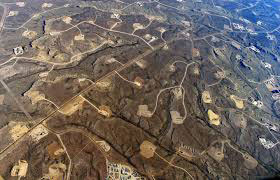A second round of draft regulations for natural gas fracking on public lands has been released by the Interior Department, which are much weaker than the previous version.
But they are still stronger than what the industry wants, which are no federal regulations. The new rules would cost industry about $20 million a year to comply, half that of the original rules.
While the first draft required natural gas drillers to disclose the chemicals they use, inspect wells after fracking and certify that drinking water supplies are safe, and prove wells aren’t leaking, the new draft steps back from that.
Interior went back to the drawing board after receiving heavy criticism from Republicans and industry that the rules would be too burdensome.
"Comparing today’s rule governing fracking on public lands with the one proposed a year earlier, it is clear what happened: the Bureau of Land Management (BLM) caved to the wealthy and powerful oil and gas industry and left the public to fend for itself," says Jessica Ennis of legal firm Earthjustice.
DeSmogBlog reports that in the 171-page document that specifies the rules, Interior’s BLM says it will adopt ALEC‘s model bill on disclosing fracking chemicals, which, according to the NY Times, was written by ExxonMobil!
ALEC’s bill is titled, "Disclosure of Hydraulic Fracturing Fluid Composition Act."
Fracking pads in Wyoming:

The new version:
- No setback requirements for how close drilling sites can be to homes and schools
- Chemicals used do not have to be disclosed before they are pumped into the ground, preventing communities from testing and monitoring the impact on water supplies.
- Chemicals can be reported afterwards on FracFocus, an industry-created website, which will make it hard for the public to track and aggregate data. "Trade-secret" chemicals do not have to be reported.
- Drillers must submit management plans but the rules stop short of banning chemical-filled wastewater stored in open air pits.
- No requirement that nearby water supplies be tested before and after drilling.
- Rather they having to test the integrity of cement barriers in every well, the industry can test one well and assume that sample holds for all similar wells. Cement barriers are the only thing that separates toxic fracking chemicals and groundwater.
"It only takes one failed cement barrier to poison an aquifer," says Ennis.
"This rule essentially says to oil companies that they can frack first and ask questions later," comments Ed Markey (D-MA), the top Democrat on the House Natural Resources committee.
"In a way, it’s all come full circle, says DeSmogBlog, because "the original chemical disclosure standards and the decision to utilize FracFocus’ database came the Department of Energy’s (DOE) industry-stacked Fracking Subcommittee formed in May 2011. DOE gave a $1.5 million grant to FracFocus.
Texas passed a bill making FracFocus the fracking chemical disclosure database in 2011, after which it became ALEC’s model bill which has been adopted by the Council of State Governments. It has since become law in Colorado, Pennsylvania and Illinois and is moving through other states.
Vast Areas of Public Land
Vast areas of public land are leased to oil and gas companies totaling the size of Florida, according to the Natural Resource Defense Council (NRDC), including the water supplies of Washington D.C., Denver, and parts of California’s Monterey, Ventura and Santa Barbara Counties.
There are over 92,000 wells on public lands, producing 13% of US natural gas and 5% of oil, reports Bloomberg.
Tens of thousands of Americans submitted comments over the past year asking Interior to keep fracking from turning treasured national parks and forests into industrial zones.
Here are some areas in danger, according to EcoWatch:
- White River National Forest (Colorado): the most visited national forest in the nation. Its pristine streams provide drinking water to nearby communities, and feeds the Colorado River.
- Delaware River basin: spans New Jersey, New York, Pennsylvania and Delaware and home to three national park areas, and drinking water for 15 million people.
- Wayne National Forest (Ohio): part of the beautiful Hocking Hills region, most of it will leased for drilling near the sole drinking water source for 70,000 people.
- George Washington National Forest (Virginia, West Virginia) streams feed the James and Potomac Rivers, which provide the drinking water for millions of people in metro D.C.
- Otero Mesa (New Mexico): an important area for wildlife and the largest untapped aquifer in the state.
Comments will be accepted for 30 days.
Read the full story about the insidious nature of these laws:
